Summer in Australia can be blistering. The average temperatures vary across different regions, from 14.8 to 31.9 degrees Celsius. Thus, having an air conditioner during this time is essential. There are various options and types available – from portable units to window models, central systems to floor-mounted units, and even sleek ductless mini-splits.
However, portable ACs are often ideal for their—you guessed right—portability, energy efficiency, multiple functions, and hassle-free setup. You also don’t have to worry about expensive modifications or installations to your home. So, in this guide, I've evaluated and shortlisted the best portable air conditioners available on the Australian market to help you stay cool this summer.
My Top Picks
My evaluation and research ended up with seven choices. But if you're short on time and need to make a quick purchase, here are my top three portable air conditioners for Aussies:
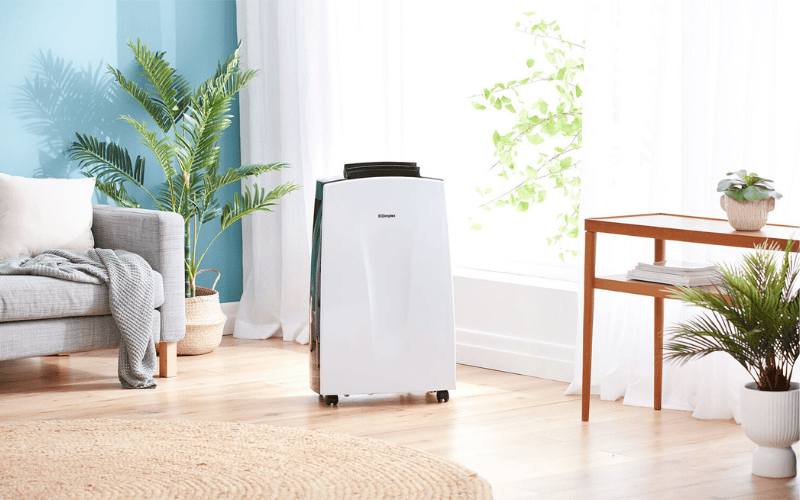
Dimplex DCP16C Portable AC
Best overall portable air conditioner with 15,354 BTU/h (4.5 kW) cooling capacity, dehumidifying function, LED display, remote control, and on/off timer.
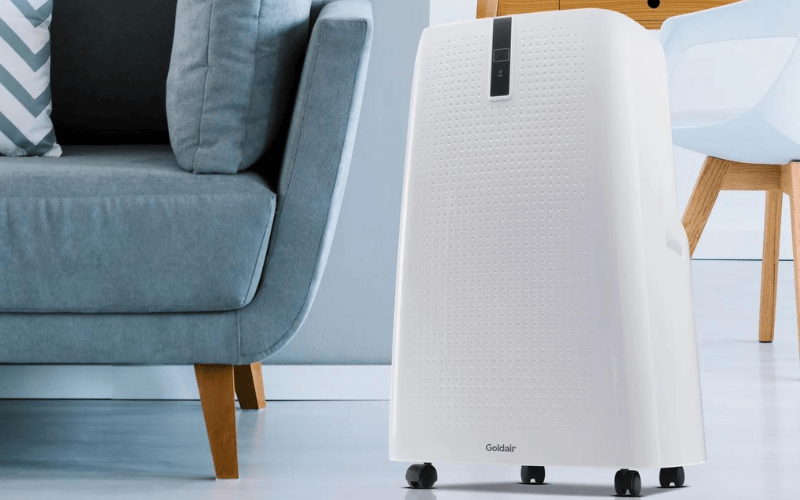
Goldair GCPAC350W Portable AC
Best smart, portable air conditioner with a 12,044 BTU/h (3.5 kW) cooling capacity, Wi-Fi connectivity, 3-in-1 functionality, and an adjustable thermostat.
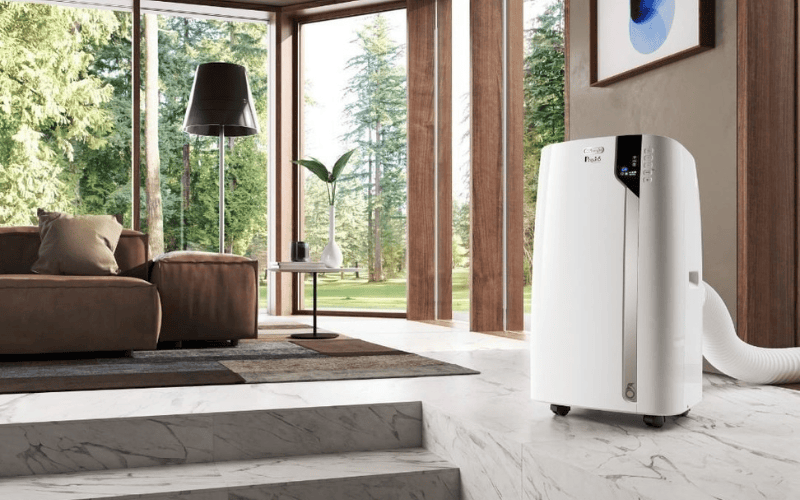
De’Longhi Pinguino Care4Me
Best multifunctional portable air conditioner with 11,000 BTU/h (2.9kW) cooling capacity, dehumidifying and fan-only functions, and temperature sensor.
Top 7 Portable Air Conditioners for Australians: Stay Cool Anywhere
Whether you’re looking for a portable AC for small rooms, large rooms, or even a model with multiple functions, Here is a detailed breakdown of the best seven air conditioners to help you find the perfect fit for your needs and space.
1. Dimplex DCP16C
Best Overall Portable Air Conditioner
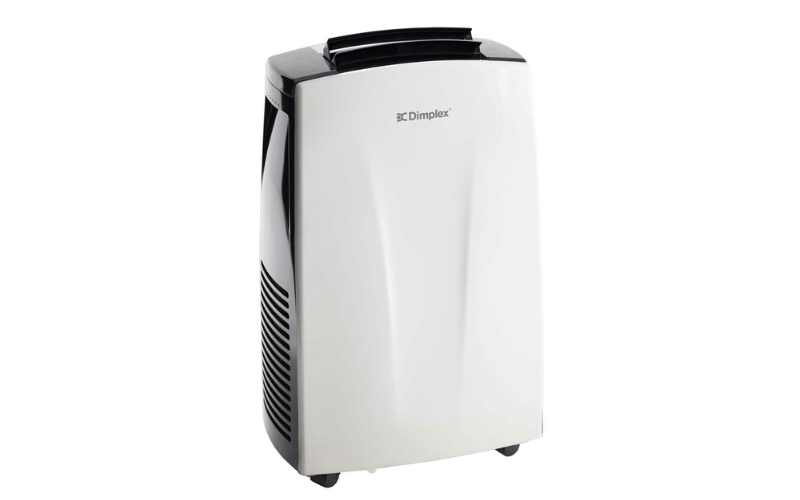
Room size: 33 sqm
Noise level: 56 dB
The Dimplex DCP16C is a compact, portable, and efficient air conditioner with an easy set-up design. Its wheeled design allows you to roll the unit from one room to another easily. However, you will need to attach the exhaust hose to a nearby window to use this air conditioner. The unit can cool spaces of up to 33 cubic metres while operating with manageable noise levels.
Dimplex's air conditioner has a handy remote control that allows for easy operation from a distance. The remote control has an LED display for added convenience when adjusting settings. You can also operate the appliance using the control panel on the top. You can raise or lower the temperature, switch between cooling and dehumidifying functions, and choose one of three fan speeds.
But that's not all. The air conditioner has a time preset, which helps save energy, and washable air filters, ensuring the air in your room is free from common irritants like pollen, dust, and debris. The appliance also uses a self-evaporative system to get rid of excess condensation. However, this requires you to open the drain hole to allow the condensed moisture to exit the tank.
Pros
- Cools up to 33m³
- Portable, no installation
- Self-evaporative, washable filters
- Built-in timer for scheduling
- Intuitive remote control
Cons
- Relatively noisy
- Manual louvre adjustment
2. Goldair GCPAC350W
Best Smart Portable Air Conditioner
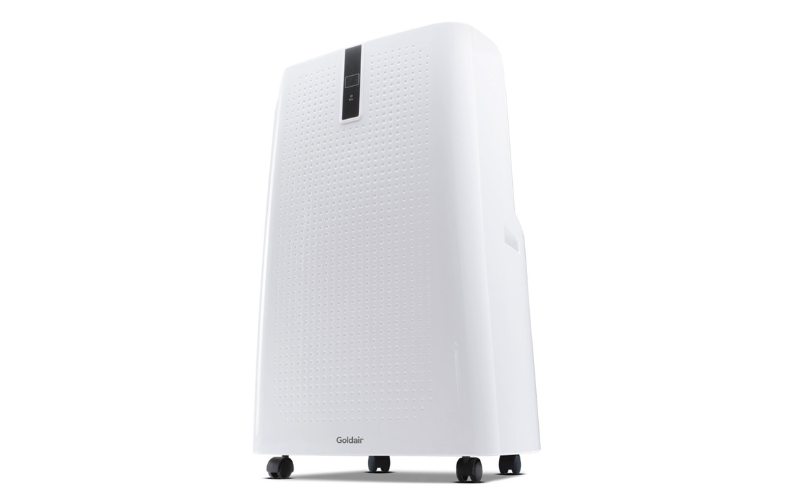
Dehumidifying capacity: 28 l/24
Noise level: 62 dB
Goldair's Portable Air Conditioner is a versatile, smart unit that boasts Wi-Fi connectivity and three-in-one functionality. It has a hot and cold function (reverse cycle) and a dehumidifying mode that reduces excess humidity in the air. I recommend it if you don't have sufficient space for a separate heater or dehumidifier. Likewise, if you fancy multifunctional units instead of individual appliances, which can be energy-consuming.
The Wi-Fi connectivity and Alexa and Google Assistant compatibility allow you to control the unit from anywhere. The unit has an intuitive digital display with electronic controls and a handy remote for easy configuration. Plus, like the Dimplex DCP16C, it has an on/off timer, so you can automatically power it to cool your room or turn it off to save energy.
More impressive, the Goldair GCPAC350W has an adjustable thermostat for optimised cooling. This feature helps maintain a comfortable and consistent temperature while ensuring efficient energy consumption. You also get three-speed settings to meet your home cooling requirements.
Pros
- User-friendly controls and remote
- Dehumidifying, hot, and cold function
- Alexa and Google Assistant compatibility
- Adjustable thermostat for efficiency
- Smart Wi-Fi connectivity
Cons
- 62 dB noise level
3. De’Longhi Pinguino Care4Me
Best 3-in-1 Portable Air Conditioner
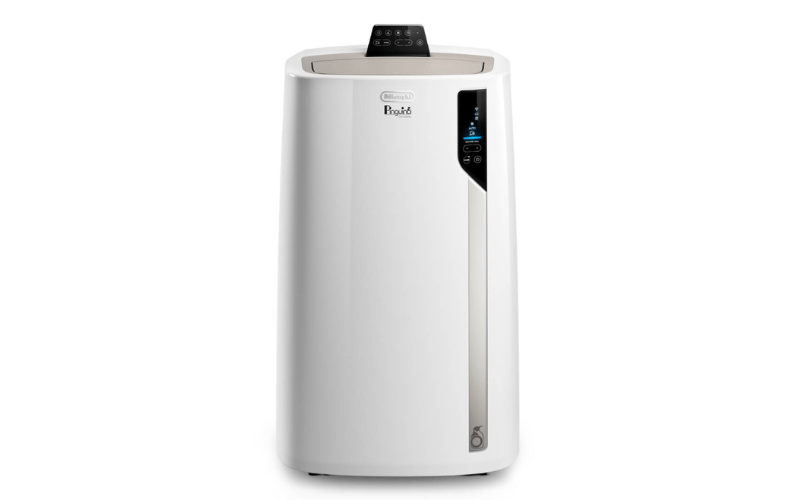
Room size: Medium-sized
Noise level: 47 - 50 dB
De’Longhi Pinguino Care4Me uses innovative technologies to optimise efficiency and increase cooling capacity while saving energy. Besides cooling, the versatile air conditioner also features dehumidifying and fan-only functions. At 33 kg, the Care4Me is surprisingly portable for its capabilities. Its durable build is complemented by sturdy handles and heavy-duty castors, facilitating easy movement around the house.
De’Longhi's portable air conditioner has good enough cooling power, offering up to 11,000 BTU output for spaces up to 110m³. In contrast to conventional models, the Pinguino Care4Me has an innovative cool surround technology, which uses the remote to monitor the humidity and temperature in your space. Then it automatically adjusts settings to optimise performance.
That aside, you also get an intuitive display screen to adjust temperature, fan speed, and mode settings. The included remote control has on/off, flap swing, silent, air flow, countdown timer, myEcoReal feel, MODE, decrease, and increase buttons, which can be used as far as 10 m from the unit. The air conditioner is my top pick for the best combination of build quality, cooling capacity, dehumidification capacity, and energy efficiency.
Pros
- Sleek, portable design
- Efficient, energy-saving cooling
- Convenient remote control
- Intuitive display screen
Cons
- 63 dB noise level
4. Olimpia Splendid COMPACT10AU
Best Portable Air Conditioner for Small Spaces
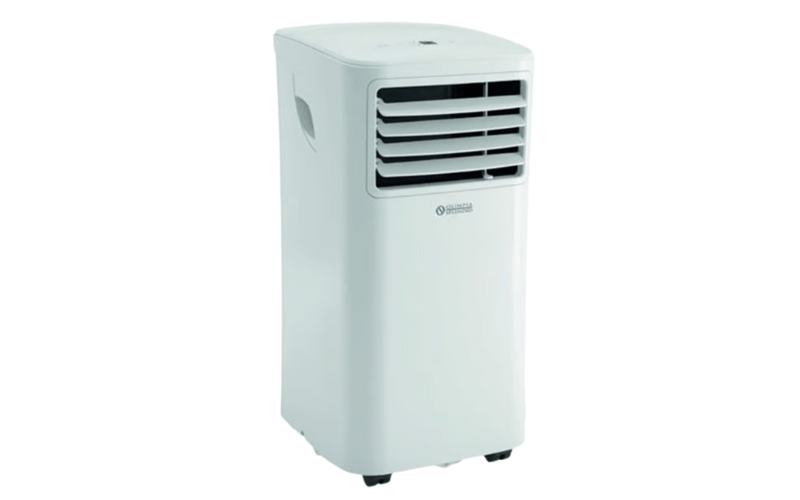
Room size: 20 sqm
Noise level: 47 - 52 dB
The Olimpia COMPACT10AU is a compact air portable conditioner that delivers quality and fairly quiet performance within 47 and 52 dBa. I recommend it for cooling small spaces due to its size, lightweight design, intuitive controls, and versatile functionality. The air conditioning unit has a window venting kit for setup. It's easy to install on both sash and hung sash windows.
The compact air conditioner is also one of the easiest models to operate. You can use the touchscreen display panel for quick and easy hi-tech control and settings or the user-friendly remote for easy mode, temperature, and time settings from the comfort of your couch or bed.
Like the Dimplex DCP16C, Olimpia's Portable Air Conditioner automatically cools and dehumidifies a room, optimising power consumption. The dehumidification function helps the unit run more efficiently and lowers energy costs. In addition to cooling the air, this air conditioner can help eliminate the odours caused by mildew, dampness, and mould.
Pros
- Compact, lightweight design
- Auto mode for efficient cooling
- Easy touchscreen and remote control
- Has integrated handles and castors
- Quick setup with window kit
Cons
- Lacks advanced features
- No turbo fan, anti-dust filter
- Sleep mode, automatic louvres missing
- No eco mode
5. TECO Reverse Cycle
Best Reverse Cycle Portable Air Conditioner
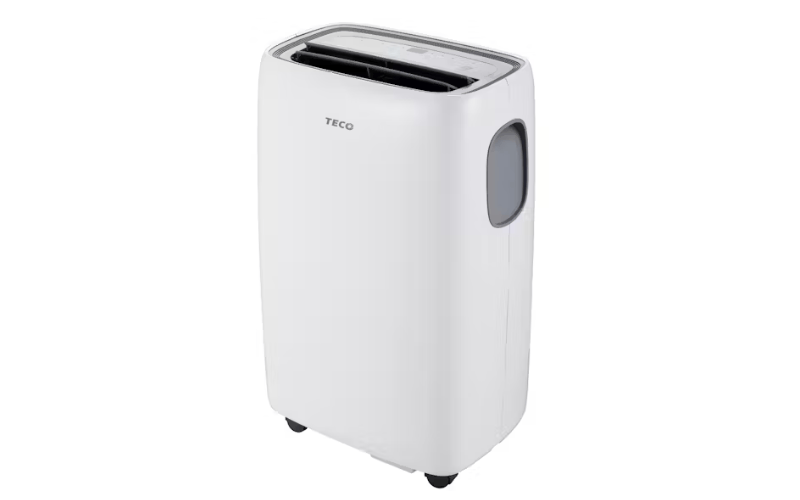
Dehumidifying capacity: 36 l/24
Room size: 30 sqm
Noise level: 64 dB
The TECO Portable Air Conditioner is a reverse-cycle air conditioner that cools the room by absorbing indoor heat and expelling it outside. Conversely, it warms the room by drawing external heat indoors. To improve its performance, the appliance uses R290 refrigerant, which is environmentally friendly and efficient. The air conditioner also has an energy-efficient dehumidification function that removes up to 1.5 L of excess moisture from your room.
While it isn’t the lightest option in this roundup, the TECO Reverse Cycle Air Conditioner has a compact, sleek design that’s easy to move from room to room as required. Positioning the machine near the window for venting isn’t a problem, thanks to the heavy-duty roll-on castors at the bottom. It includes an innovative window kit that fits Australia's popular window types. The kit allows the appliance to channel hot air outside when using the cooling mode.
Like many others on the list, the TECO Reverse Cycle has built-in Wi-Fi technology that allows for enhanced energy productivity. It’s also super easy to operate the machine remotely via the TECO app on your mobile device.
Pros
- Innovative window kit
- Effective reverse cycle function
- Energy-efficient dehumidification
- Wi-Fi and remote control
- User-friendly features
Cons
- Relatively pricey
- Limited capacities for larger rooms
- 64 dB noise level
6. Rinnai RPC41NC
Best Portable Air Conditioner for Large Rooms
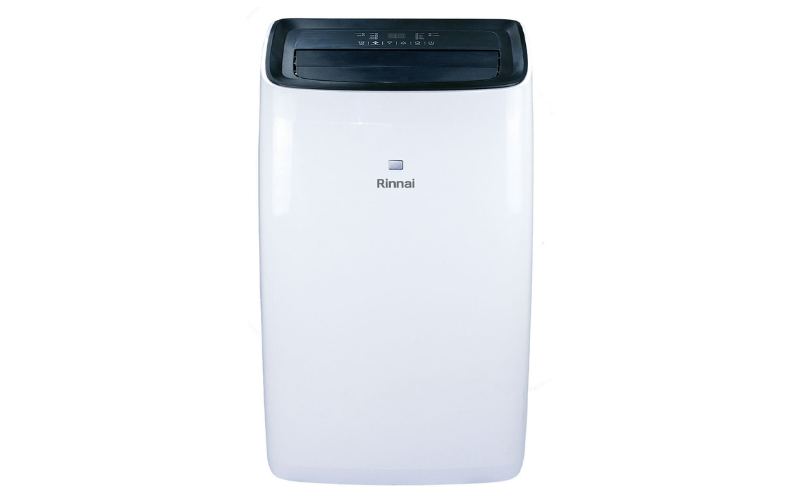
Room size: 30 sqm
Noise level: 65 dB
The Rinnai RPC41NC offers practical functions to cool large rooms, including bedrooms and home offices. It's easy to operate with the handy remote control and sleek control panel. You can activate specialised functions like the sleep mode or the built-in timer from your couch to meet your room cooling requirements.
You also get a smart auto mode that operates on fan mode when the room temperature is below twenty-three degrees and runs on cool mode when the temperature rises above twenty-three degrees for extra efficiency and convenience. Besides these, the appliance also has a dry mode.
Rinnai's air conditioner gets rid of the water it makes through the exhaust pipe thanks to its self-evaporative system. So you won't keep getting up to empty the water tray. Likewise, cleaning its washable filters is as easy as detaching the outer grills and removing the filters. I recommend using a vacuum cleaner or a soft, damp cloth to preserve the appliance’s performance.
Pros
- Smart auto mode
- Easy operation with remote control
- Washable filters for easy cleaning
- Self-evaporative system
Cons
- Loud at highest fan speed
- No dehumidification function
7. YRIGHT FRKH-L14
Best Cheap Portable Air Conditioner
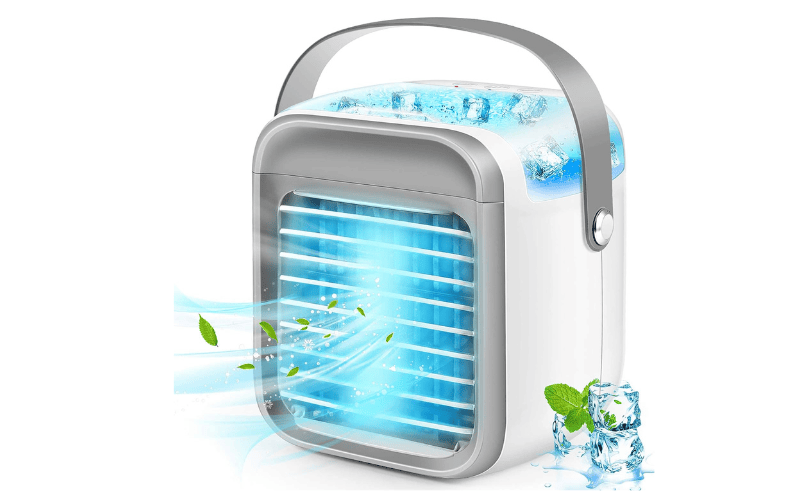
Tank capacity: 300 ml
Power source: Battery-Powered
The YRIGHT FRKH-L14 Air Cooler is an affordable air conditioner with evaporative technology. It has three unique functions: it serves as a personal air conditioner for cooling your home, has a fan mode to improve airflow, and humidifies your room's air.
Being a cordless appliance, the YRIGHT FRKH-L14 is also ideal if you want an extremely portable air-cooling system. You can place it anywhere in your home or even take it outdoors during picnics. It's rechargeable, with a 4 to 5 hours battery life. And the ability to charge it with a type-C cable, car charger, or a power bank ensures that it's always ready for use.
YRIGHT's budget-friendly air cooler has a convenient tank capacity of around 300 ml. So you don’t have to worry about frequent refills. My only complaint is coverage—you won't feel the cool air more than 4 m away.
Pros
- Cordless design
- Rechargeable and energy-efficient
- Large tank for less frequent refills
- Multifunctional—AC, fan, humidifier
- Convenient charging options
Cons
- Limited coverage
How I Researched the Best Portable Air Conditioners?
Efficient cooling solutions are a priority for many households. My search for the best portable air conditioners was driven by the need for a unit that could provide comfort without the commitment of a fixed installation.
Thus, I evaluated many products based on their cooling efficiency, ease of use, energy consumption, and overall value for money. My aim was to sift through the marketing noise and find portable air conditioners that genuinely met the cooling needs of the average Australian home and to be able to arm you with the knowledge to make an informed decision.
Through a meticulous comparison of technical specifications, reviews, and hands-on testing, I identified key features that distinguish the best portable air conditioner. The two most important were the unit's BTU rating, which determines its cooling power, and energy efficiency, which translates to long-term cost savings. Accessibility features such as remote controls, programmable timers, and easy-to-clean filters were also on my checklist.
My research also extended to discussions with experts and technicians to understand the longevity and maintenance requirements of each model. All of these findings helped me shortlist the best portable air conditioners that offer a reliable and convenient cooling solution.
How Does a Portable Air Conditioning Unit Work?
The core function of a portable air conditioner is to transfer heat from the interior of a room to the outside. This process involves refrigeration cycles similar to those in standard air conditioning systems. I'll explain how the components work in unison to achieve this goal.
- Compressor: Pressurises refrigerant to release heat.
- Evaporator: Absorbs heat from the air.
- Condenser: Dispels the absorbed heat.
- Expansion Valve: Regulates refrigerant flow.
- Fan: Circulates air over the evaporator and condenser.
- Controls: Allow for temperature and mode adjustments.
Each component plays a vital role in the operation of a portable air conditioner. These appliances also rely on exhaust hoses to dispel the warm air that is generated during the cooling process. Below, I'll examine the various types of portable units, including single-hose, dual-hose, and evaporative models, and how they manage airflow to optimise cooling performance.
Portable air conditioning units provide a convenient solution for cooling spaces where traditional and split-system air conditioners are impractical. Unlike fixed installations, these mobile units offer flexibility and adapt to a variety of settings, from homes to offices.
What Type of Portable Air Conditioner Should You Get?
There are three different types of portable air conditioning units on the Australian market: single-hose, dual-hose, and evaporative. All three differ in price, features, and performance.
Type #1 - Single-Hose
The most popular portable air conditioning units have a single-hose design. They pull in warm air, use mechanical means to cool it, and then release the cooled air back into the room through top or front louvres.
The excess heat in the machine is expelled outdoors through the single hose, which is attached to the back of the unit. However, the single hose doesn’t draw enough air from the outside to cool the heated components in the machine. So, the machine resorts to drawing more air from the room to cool its internal components, which causes negative pressure to build up in the room.
If you don’t properly seal the window or any other openings, air from outside will force its way in at a higher rate. Consequently, the machine works extra hard to cool the excess air.
Type #2 - Dual-Hose
Portable air conditioners with a dual-hose design pull in warm air from the room, cool it and distribute it back into the room. However, thanks to the dual-hose design, they don’t pull air from the room to cool the internal components. You have an intake and exhaust hose at the back of the unit.
The exhaust hose is the usual venting pipe that comes with single-hose ACs and its main function is to expel heat outside. The intake hose draws in air from the outside to help cool down the mechanical components in the machine. The excess air this pipe helps draw in prevents negative pressure since the machine doesn’t have to pull air from the room.
So, dual-hose AC units usually have a superior energy efficiency rating than single-hose. I often recommend them for larger rooms, but they are also often more expensive than other types.
Type #3 - Evaporative
Evaporative portable air coolers do not have a condenser or compressor like traditional air conditioners. Instead, they use the process of evaporation to cool the air. Water is poured into the cooler and then evaporated, which cools the air being blown out by the fan.
These coolers do not require venting hoses because they do not have internal mechanical components that generate heat and need cooling. This makes them truly portable, as they do not need to be connected to a window kit. They are most effective in areas with low humidity.
However, it's important to note that while evaporative coolers can help cool the air, they may not be as effective as traditional air conditioners in very humid environments or for cooling large spaces. They are a more energy-efficient option and are best suited for hot, dry climates.
What to Consider When Comparing Portable Air Conditioners?
To choose the best portable air conditioner for your cooling needs, here are seven factors to consider.
#1 - Room Size
Room size is the most important factor. If a portable air conditioner is too small, it will not fully cool the entire room. If it’s too large, it will cool the room without removing excess moisture from the air. The cooling capacity of portable air conditioning units is usually measured in BTUs per hour. The more BTUs a portable AC has, the more room it can cool.
The standard rule is that a portable air conditioner unit needs approximately 20 BTU for each square foot of floor space you're cooling. For example, to calculate your portable AC unit size for a 400ft² room (approximately 37m²), you will need to multiply 400 (the surface) times 20 (the required BTUs per square foot), which will make it an 8000 BTU air conditioner.
#2 - Energy Efficiency
You don’t want a portable AC that will skyrocket your electricity bills. So, it’s important to check the energy rating of the unit. You can find the rating on the energy label of the unit. A normal portable AC will only have a blue star rating, whereas a reverse cycle model will have a blue star (for cooling) and a red star (for heating) rating on the label.
A typical energy rating label for a portable air conditioner has seven energy efficiency classes labelled A++, A+, A, B, C, D, and E, from top to bottom. The most efficient portable ACs tend to have a rating of A++. Make sure the model you are considering has an energy rating of not less than A. However, models in the B energy efficiency class aren’t so bad.
The energy efficiency of some portable air conditioners is expressed with an EER (Energy Efficiency Rating) rather than the A++ to E scale. The EER rating is the ratio between the cooling effect (in BTU) and the electrical power input (in W). The average EER is 8.523, so choose units with a higher EER for better efficiency.
#3 - Noise Level
Noise level is another crucial factor to consider, especially if you intend to use your portable AC at night. Some models tend to be very noisy when operating at full power, while others are bearable. Most portable ACs have a noise rating on the product page, which usually ranges from 50 to 75 dB.
You can take the brand’s word for it, but I recommend testing the unit’s noise level before purchasing. The latter may not be possible when buying from an online marketplace. You can get more insights on the noise level of the machine from existing customer reviews or online forums.
#4 - Operating Modes
In most cases, people only look for portable air conditioners for cooling purposes. However, you can find products that offer multiple functions. The best models on the Australian market can cool, dehumidify, and enhance airflow. In addition, some portable air conditioners can cool and heat your room (reverse cycle) depending on weather conditions.
Others have smart and energy-saving modes for improving performance and efficiency. Smart portable ACs detect temperature changes and adjust accordingly. Along with smart temperature sensing, most high-end models have advanced technologies like Wi-Fi and Bluetooth Connectivity. These technologies allow for remote operation of the machine for added convenience.
#5 - Controls
What type of controls does the portable AC have? Conventional models tend to have a control panel only, requiring you to operate the machine physically. But the latest designs include a control panel, remote control, and mobile app connectivity. So, you can operate the appliance from the comfort of your couch or bed. I also recommend machines with full LED controls and labels.
#6 - Louvre Design
Portable ACs may come with manually adjustable, fixed, or automatic louvres. Of the three, automatic louvres are the most convenient for effective cooling, airflow, and dehumidification. While at it, consider the layout of your room and the position of the louvres on the machine.
#7 - Easy Setup and Portability
All portable air conditioners except evaporative air coolers have a venting system for expelling hot air outside. The hose is usually attached to a window or door kit. Make sure the model you’re getting comes with a kit that’s compatible with your window or door for ease of use.
Likewise, the best portable air conditioners have integrated handles for lifting and easy-rolling castors to move the unit from one point to another. If you intend to move your air conditioner frequently, then consider the weight of the machine alongside these features.

Frequently Asked Questions (FAQs)
Here are some frequently asked questions about portable air conditioners in Australia.
What is a good size portable air conditioning unit?
A good size for a portable air conditioning unit often depends on the size of the room it will be used. For small rooms, such as a single bedroom or living room area, a unit with a cooling capacity between 7,000 and 10,000 BTUs is often sufficient. However, as the space increases, so does the cooling power you'll need to maintain a comfortable temperature.
What is the best alternative to air conditioning?
The best alternatives to air conditioning include:
- Evaporative coolers or swamp coolers: These use water to cool the air.
- Powerful fans: Room or whole house fans can circulate air to create a breeze in your room.
- Solar cooling: This uses the sun's energy to cool your home.
- Geothermal heating and cooling: This uses the earth's temperature to regulate your home's temperature.
- Attic fan: Attic fans draw hot air out of your attic and lower the temperature of your home.
- UV-reflective window film, thermal curtains, or plants: These block or reduce the heat from the sun.
Each of these alternatives offers unique benefits, including cost-effectiveness and temperature-lowering power. However, the effectiveness of each alternative can depend on various factors, such as the climate where you live, the size of your home, and your specific cooling needs.
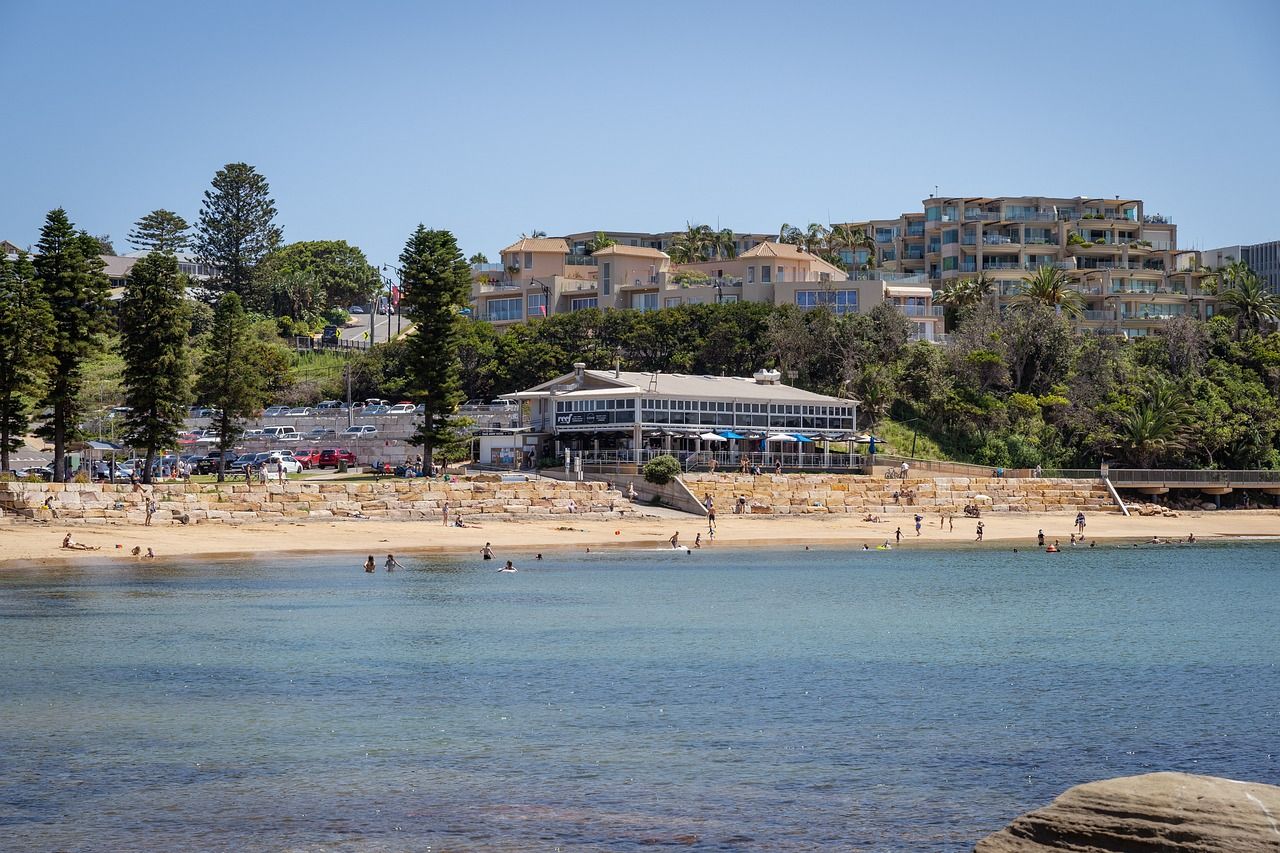
Wrapping Up
While portable air conditioners are appealing on hot summer days, they are not necessarily a cure-all appliance, nor are they exactly portable since you have to hook them to a window to vent hot air outside.
So, make sure your selection process is thorough. Consider every little aspect, including your room size, energy efficiency, capacity, noise, operating modes, controls, and unique features, to ensure you have the right pick for your cooling needs and requirements.








